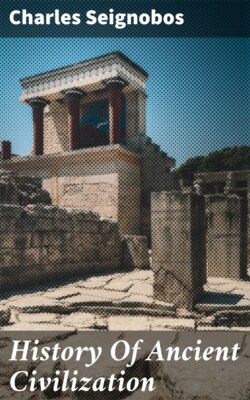Читать книгу History Of Ancient Civilization - Charles Seignobos - Страница 15
На сайте Литреса книга снята с продажи.
SOURCES OF INFORMATION FOR THE HISTORY OF ANCIENT PEOPLES
ОглавлениеThe Sources.—The Assyrians, Greeks, and Romans are no longer with us; all the peoples of antiquity have passed away. To know their religion, their customs, and arts we have to seek for instruction in the remains they have left us. These are books, monuments, inscriptions, and languages, and these are our means for the study of ancient civilizations. We term these sources because we draw our knowledge from them. Ancient History flows from these sources.
Books.—Ancient peoples have left written records behind them. Some of these peoples had sacred books—for example, the Hindoos, the Persians, and the Jews; the Greeks and Romans have handed down to us histories, poems, speeches, philosophical treatises. But books are very far from furnishing all the information that we require. We do not possess a single Assyrian or Phœnician book. Other peoples have transmitted very few books to us. The ancients wrote less than we, and so they had a smaller literature to leave behind them; and as it was necessary to transcribe all of this by hand, there was but a small number of copies of books. Further, most of these manuscripts have been destroyed or have been lost, and those which remain to us are difficult to read. The art of deciphering them is called Palæography.
The Monuments.—Ancient peoples, like ourselves, built monuments of different sorts: palaces for their kings, tombs for the dead, fortresses, bridges, aqueducts, triumphal arches. Of these monuments many have fallen into ruin, have been razed, shattered by the enemy or by the people themselves. But some of them survive, either because there was no desire to destroy them, or because men could not. They still stand in ruins like the old castles, for repairs are no longer made; but enough is preserved to enable us to comprehend their former condition. Some of them are still above ground, like the pyramids, the temples of Thebes and of the island of Philæ, the palace of Persepolis in Persia, the Parthenon in Greece, the Colosseum in Rome, and the Maison Carrée and Pont du Gard in France. Like any modern monument, these are visible to the traveller. But the majority of these monuments have been recovered from the earth, from sand, from river deposits, and from débris. One must disengage them from this thick covering, and excavate the soil, often to a great depth. Assyrian palaces may be reached only by cutting into the hills. A trench of forty feet is necessary to penetrate to the tombs of the kings of Mycenæ. Time is not the only agency for covering these ruins; men have aided it. When the ancients wished to build, they did not, as we do, take the trouble to level off the space, nor to clear the site. Instead of removing the débris, they heaped it together and built above it. The new edifice in turn fell into ruins and its débris was added to that of more remote time; thus there were formed several strata of remains. When Schliemann excavated the site of Troy, he had passed through five beds of débris; these were five ruined villages one above another, the oldest at a depth of fifty feet.
By accident one town has been preserved to us in its entirety. In 79 A.D. the volcano of Vesuvius belched forth a torrent of liquid lava and a rain of ashes, and two Roman cities were suddenly buried, Herculaneum by lava, and Pompeii by ashes; the lava burnt the objects it touched, while the ashes enveloped them, preserving them from the air and keeping them intact. As we remove the ashes, Pompeii reappears to us just as it was eighteen centuries ago. One still sees the wheel-ruts in the pavement, the designs traced on the walls with charcoal; in the houses, the pictures, the utensils, the furniture, even the bread, the nuts, and olives, and here and there the skeleton of an inhabitant surprised by the catastrophe. Monuments teach us much about the ancient peoples. The science of monuments is called Archæology.
Inscriptions.—By inscriptions one means all writings other than books. Inscriptions are for the most part cut in stone, but some are on plates of bronze. At Pompeii they have been found traced on the walls in colors or with charcoal. Some have the character of commemorative inscriptions just as these are now attached to our statues and edifices; thus in the monument of Ancyra the emperor Augustus publishes the story of his life.
The greatest number of inscriptions are epitaphs graven on tombs. Certain others fill the function of our placards, containing, as they do, a law or a regulation that was to be made public. The science of inscriptions is called Epigraphy.
Languages.—The languages also which ancient peoples spoke throw light on their history. Comparing the words of two different languages, we perceive that the two have a common origin—an evidence that the peoples who spoke them were descended from the same stock. The science of languages is called Linguistics.
Lacunæ.—It is not to be supposed that books, monuments, inscriptions, and languages are sufficient to give complete knowledge of the history of antiquity. They present many details which we could well afford to lose, but often what we care most to know escapes us. Scholars continue to dig and to decipher; each year new discoveries of inscriptions and monuments are made; but there remain still many gaps in our knowledge and probably some of these will always exist.
